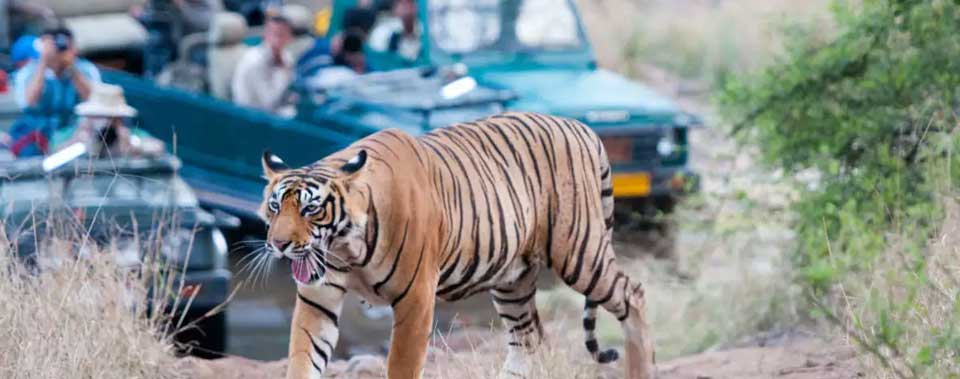The majestic tigers of Kanha National Park have long captured the imagination of wildlife enthusiasts and nature lovers. With its sprawling forests, lush meadows, and abundant prey, Kanha offers a perfect habitat for these magnificent creatures. While every zone in the park has its own unique charm, there are certain areas that are renowned for their tiger sightings and are considered the best tiger zones in Kanha. Let's explore these zones and discover the thrilling world of the royal Bengal tigers.
The Core Zones of Kanha National Park:
1.Kanha Zone:Located in the central part of the park, the Kanha Zone is one of the most popular and sought-after zones for tiger sightings. It is home to some of the park's iconic tigers, and the lush Sal forests and open grasslands create an ideal habitat for these majestic cats. The Kanha Zone is accessed through the Khatia Gate.
2.Sarahi Zone:Situated in the southwestern part of Kanha, the Sarahi Zone is known for its scenic beauty and abundant wildlife. The dense forests and meandering streams offer a picturesque setting for tiger sightings. The Sarahi Zone can be entered through the Mukki Gate.
3.Mukki Zone:Located in the western part of the park, the Mukki Zone is another prime tiger territory in Kanha. It is known for its diverse landscape, including grasslands, bamboo forests, and rugged terrains, which provide ample opportunities for tiger encounters. The Mukki Zone is accessed through the Mukki Gate.
4.Kisli Zone:Situated in the eastern part of Kanha, the Kisli Zone is famous for its thriving tiger population and scenic beauty. It is characterized by Sal forests, meadows, and water bodies, creating a habitat that is favored by tigers. The Kisli Zone can be entered through the Kisli Gate.

The Buffer Zones of Kanha National Park:
1.Khatia Zone:Located in the buffer area of Kanha, the Khatia Zone is the main entry point for visitors. It serves as the administrative and tourism hub of the park, offering various accommodations and facilities. While tiger sightings are not as frequent as in the core zones, the Khatia Zone provides opportunities to spot other wildlife species and enjoy the park's natural beauty.
2.Sijhora Zone:Situated in the northern buffer area of Kanha, the Sijhora Zone is characterized by its hilly terrain and dense forests. It is known for its birdlife and offers a tranquil atmosphere for nature enthusiasts. Wildlife sightings, including tigers, are possible but less frequent compared to the core zones.
3.Phen Zone:Located in the southern buffer area of Kanha, the Phen Zone is known for its picturesque landscapes and diverse wildlife. It offers a mix of grasslands, forests, and water bodies, creating an ideal habitat for various animal species. While tiger sightings are relatively rare, the Phen Zone provides opportunities for exploring the park's biodiversity.
4.Khapa Zone:Situated in the eastern buffer area of Kanha, the Khapa Zone is characterized by its rolling hills, grasslands, and mixed forests. It is less frequented by tourists, offering a peaceful and off-the-beaten-track experience. While tiger sightings are not as common as in the core zones, the Khapa Zone is known for its scenic beauty and tranquility.
To make the most of your Kanha jungle safari and increase your chances of tiger sightings, it is advisable to hire experienced naturalists and guides who are familiar with the park's terrain and animal behavior. They can provide valuable insights and help you navigate through the wilderness in search of the elusive tigers.
When planning your visit to Kanha National Park, it is recommended to allocate sufficient time to explore multiple zones and increase your chances of tiger sightings. A minimum of three to four days is ideal for a comprehensive safari experience in Kanha.
During your jungle safari, it is not just the tigers that will captivate your attention. Kanha is home to a diverse range of flora and fauna that make the park a biodiversity hotspot. Apart from tigers, you may encounter leopards, sloth bears, Indian gaurs, wild dogs, and a variety of deer species such as sambar, chital, and barasingha. The park is also a birdwatcher's paradise, with over 300 species of resident and migratory birds, including the colorful Indian roller, the majestic crested serpent eagle, and the elusive Indian pitta.
To enhance your experience, it is advisable to follow the guidelines and regulations set by the park authorities. These include maintaining a safe distance from the wildlife, refraining from littering, and respecting the park's tranquility. Remember, Kanha National Park is a protected area dedicated to conservation, and it is our responsibility to preserve its natural treasures.